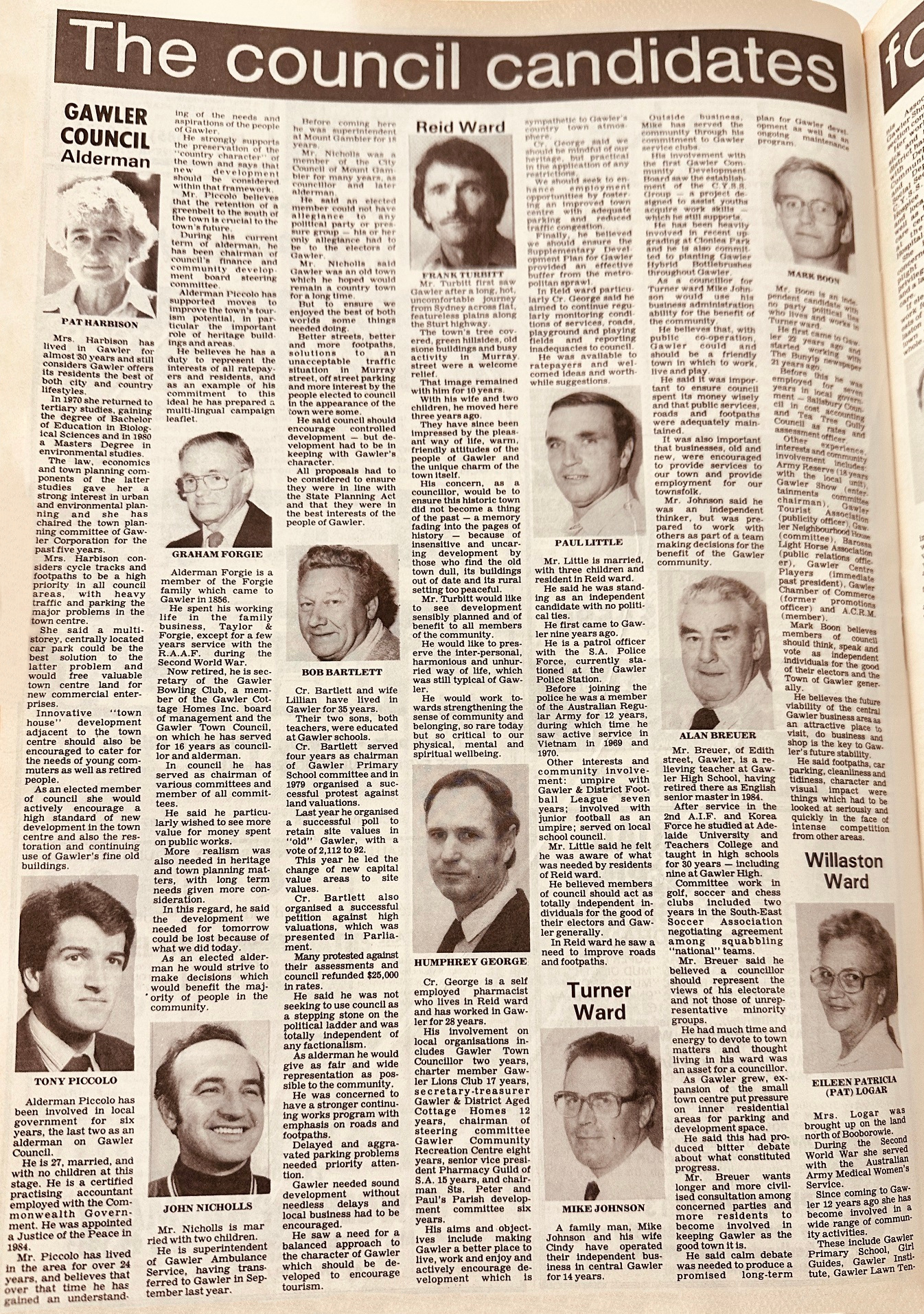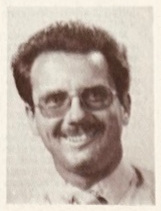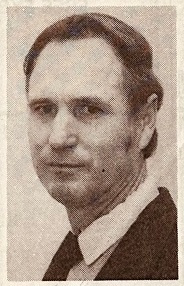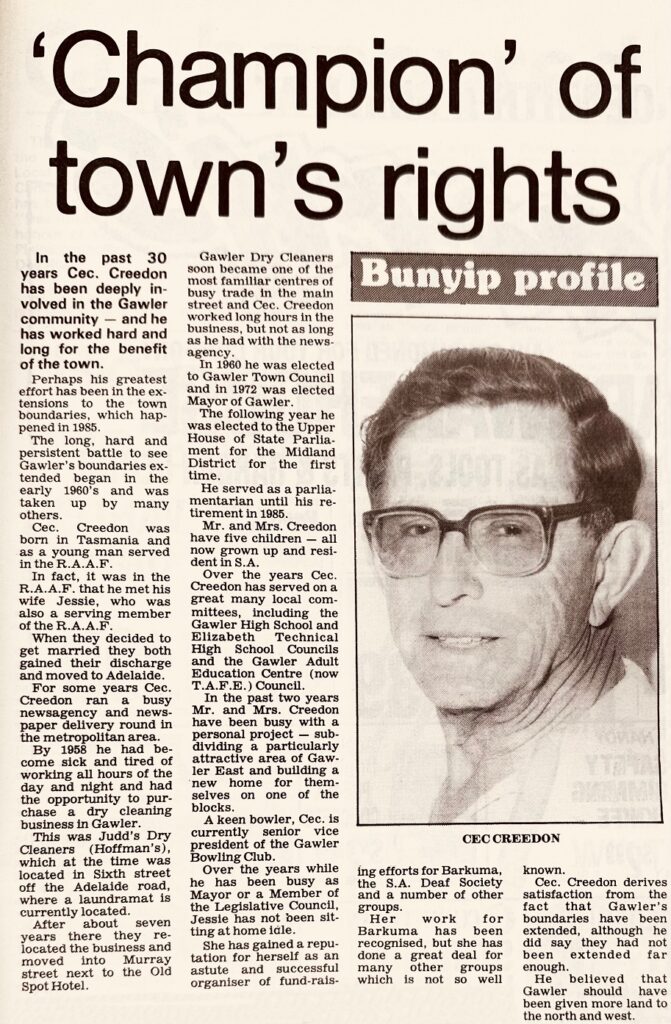There were a lot of things happening in 1987. The world’s population reached 5 billion for the first time, while The Simpsons debuted as an animated short and the Nintendo Entertainment System was officially released in Australia, featuring culture-defining classics like Super Mario Bros. and The Legend of Zelda.
Notably for our purposes, it’s also a year where we have a group photo of the Council. Gil Harnett is sitting in the Mayor’s official chair here, which the Council has had for over 150 years. We don’t use it in an official capacity anymore, but it’s such a stylish chair that when Santa shows up at the Civic Centre every December we bring it out of storage for him.

Back row: Humphrey George, Michael Johnson, Robin John (Town Manager), Mark Boon, Danny Bombardieri, Bernie Stack, Paul Little.
Front row: David Moore, Tony Piccolo, Bob Bartlett, Gil Harnett (Mayor), Graham Forgie, Betty Jacob, Ron Folland.
There is a lot of symbolic power in chairs. In fact, powerful positions often use chair-related words: for example, the leader of an organisation is often called the chairperson (which is self-explanatory) or the president (which is basically Latin for “the one who sits in front”).
So, it’s no surprise that Gawler would have an important chair of its own, which (to my current understanding) was donated by Gawler founding father James Martin. The chair itself has fallen out of use (we’ve switched to office chairs), but it still retains its symbolic power – after all, to chair a meeting, one must first sit in the Mayor’s designated seat.
In any case, to get back on-topic somewhat, our election coverage is well into the ’80s now. I can tell because the award-winning hairdressers featured in The Bunyip have hair that couldn’t have come out of any other decade.

The Bunyip, April 1st, 1987.
Sadly, it doesn’t seem like any of the Councillors of this year were in on this puffy hair trend, though Tony Piccolo’s hair is certainly floppier than I’ve ever seen it. Now, let’s get into the elections.
The Mayor

The Bunyip, April 1st, 1987.
Gil Harnett was re-elected unopposed as Mayor at this election. For voters, he was a familiar figure, already nine years into his term as Mayor. For those of us working backwards through time, though, it’s the first Mayoral election we’ve seen him in.
While he had no challengers at this election, he did have some challenges, namely the newly introduced rules around conflict of interest.

The Bunyip, February 4th, 1987.
A common theme we’ll be seeing over the 1980s is that the government had begun introducing new conflict of interest regulations to local government, which required Councillors to leave the room if they could get a personal material gain from the item being discussed.
To major Murray Street traders like Gil Harnett and Humphrey George, who had operated Harnett and George Pharmacy together for the past 30 years (amongst a variety of other Gawler land holdings), this functionally meant that they were in and out of Council meetings like yo-yos when certain topics were on the agenda.
Even if there’s no direct financial tie between the Elected Member and the item, sometimes it can still be perceived as dodgy to stay and vote, leading Councillors to step out in order to avoid accusations of feathering their own nests. It seems that the question of car parking on Murray Street was one such tricky item for Gil Harnett and Humphrey George.
The Councillor Elections
As always, here is a list of candidate profiles to peruse at your leisure. This is 16 out of 20 who ran for Council; we only have two uncompetitive wards this time.


The Bunyip, April 29th, 1989.
The Alderman Election
In the absence of a Mayoral election, an Alderman election can be the next-most exciting thing. Here we see Bob Bartlett’s strong momentum that led into his successful run for Mayor at the subsequent election.

Winner (1485 votes): Bob Bartlett
- Incumbent Ward Councillor making a successful switch to an Alderman position.

Winner (223 votes): Graham Forgie
- Incumbent Alderman. First elected to Council 18 years prior.
- The fourth-generation owner of Taylor and Forgie, a funeral care business that has existed in Gawler since 1855.

Winner (583 votes): Tony Piccolo
- Incumbent Alderman.
- There was apparently no official shape for candidate profile photos yet because this photo is a lot longer than the last two.

Missed out (273 votes): Pat Harbison
- Incumbent Alderman and Deputy Mayor.

Missed out (76 votes): John Nicholls
NewA former City of Mount Gambier Councillor.- I don’t think I’ve ever mentioned this rule previously, but at least one prior term on Council is required in order to nominate as an Alderman. However, it doesn’t specify which council, so this guy was able to jump straight into the deep end.
My placing of Graham Forgie with 223 votes above Tony Piccolo with 583 votes was intentional; Forgie was elected first. This is because the election was decided by the preferences of Bob Bartlett, whose 1485 votes made up more than two full quotas on first preferences (quota would have been 661, for the record).
Hardly any of Bartlett’s 824 spare preferences went to Tony Piccolo, who was only 78 votes away from being elected after the initial count. According to the Bunyip, the result of the contest for third place between Tony Piccolo and Pat Harbison was not decided until a “lengthy examination of preferences”, so Bartlett’s preferences were clearly very pointed in opposition to Piccolo.
In fact, while Tony Piccolo has lost a couple of (State) elections, this might be the only time I’ve ever seen him finish third. That was enough to get him elected in this case, but it was a close one.
If you feel like all this talk of preference flows is going over your head but would like to learn more, I would recommend my post about the 1991 Gawler Council elections, where a similar event occurs during the Alderman elections and I explain it in more detail.
Willaston Ward
This was a highly contested seat – five candidates for two positions.

Winner (222 votes): Bernie Stack
- New.
- 35 years old, and operator of Gawler Toyota on Murray Street. He’s been regularly showing up in the Bunyip around this time period in his other capacity as a sports car racer.

Winner (169 votes): Ron Folland
- Incumbent.
- Willaston Ward representative since 1981.

Missed Out (91 votes): Pat Logar
- New.
- Served with the Australian Army Medical Women’s Service during World War II.

Missed Out (75 votes): John Nicolson
- New.
- While he missed out this time, he later ran for Council successfully in 1995.

Missed Out (28 votes): Terry Masters
- New.
- 28 years old, the past five of them as a resident of Willaston.
Incumbent Ward Councillor Narelle Martin did not re-contest the ward.
Turner Ward
Three candidates for two positions, with no incumbents running.

Winner (268 votes): Mark Boon
- New.
- At the time of the election, he was 21 years into his employment as a journalist at The Bunyip.

Winner (199 votes): Mike Johnson
- New.
- Had opened and run the Gawler Foodland with his wife Cindy since 1973.

Missed Out (114 votes): Alan Breuer
- New.
- A retired teacher, teaching for 30 years including nine at Gawler High School.
Neither incumbent ran in this ward as Bob Bartlett ran for an Alderman position and Valerie Gravestock did not re-contest.
Reid Ward
Three candidates for two positions.

Winner (349 votes): Humphrey George
- Incumbent.
- A longtime partner in Harnett & George Pharmacy alongside Mayor Gil Harnett. There is a reserve named after him in Evanston Park, though I haven’t been able to track down the story behind that yet.

Winner (102 votes): Paul Little
- New.
- The only candidate who ran in both this election and the 2022 election.

Missed Out (130 votes): Frank Turbitt
- New.
- Moved into Gawler three years prior to the election.
Incumbent Ward Councillor Robert Towers did not seek re-election. Paul Little was behind on first-preference votes here but Humphrey George’s voters must have preferenced him highly.
The Automatic Winners
There were only two wards without competition this time around.
Winners (Carleton Ward): Betty Jacob (incumbent), David Moore (new)
- Incumbent Councillor Geoffrey Watson didn’t re-contest. Betty Jacob became the only woman elected to this Council.
Winners (Martin Ward): Peter Graham (new), Keith Bugg (incumbent)
- Danny Bombardieri did not re-contest. However, this did not last long, as Keith Bugg resigned in 1988 and was replaced by Danny again in a by-election.
Meanwhile, in Boundary Reform

The Bunyip, April 1st, 1987
This is a community profile of Cec Creedon, who was the Mayor before Gil Harnett (from 1972-1978). I found it interesting partly due to its commentary on the recent changes to the Gawler Council boundaries.
We’ll be covering it more in-depth next time, but basically, Gawler’s council boundaries were majorly expanded in 1985, almost doubling the population from around 6,500 to 11,500. This article provides context on how long it all took, with over two decades separating the start of the boundary reform process in the early 1960s from its resolution in 1985.
This article (from 36 years ago) also predicted the modern Council boundary debate – Creedon concluded that he didn’t believe the boundaries had been extended enough, and that Gawler “should have been given more land to the north and west”. We’d be having very different discussions today if they did.
Mayor Gil Harnett also had plenty to say about the decision:

The Bunyip, May 6th, 1987.
Mayor Harnett briefly addresses something that I’d love to learn more about, which is the actual financial detail behind these significant changes. The current-day Gawler Council has been asking many of these process questions for a while without getting any clear answers from the State Government. Which parties are paying how much for what? Does a Council that loses land need to be reimbursed or subsidized for it?
I’m not worried that these questions can’t be resolved – after all, there is plenty of precedent for boundary changes getting through, so clearly they figured it out at the time. However, the state government should really be clarifying these things up-front instead of seemingly making it all up as they go.
The Heritage Building Battle
The decision that most split the Council in 1987 was around a subject still prominent in local discourse today – the demolition of heritage buildings.

The Bunyip, April 1st, 1987.
The Whinnen brothers claimed that they were legally entitled to demolish this building that dated back to the 1850s, but this was… not an opinion shared by everybody.

The Bunyip, April 1st, 1987.
The decision on whether to initiate proceedings against the Whinnens and the demolition contractors split the Gawler Council right down the middle. Councillors Tony Piccolo, Narelle Martin and Keith Bugg called an emergency meeting to discuss the issue, and the debate became heated.

The Bunyip, April 8th, 1987
It seems that the initial motion, to institute proceedings against both the Whinnens and the contractors, was contested, as some did not feel that Council should be targeting the Whinnens (who were now retired). Alderman Tony Piccolo moved an amendment to change this, but the vote on this was split 5-5 and Mayor Gil Harnett broke the tie by shooting it down.
This meant that the motion went back to targeting both groups, which didn’t have the support and was voted down more strongly.
Notably, this emergency meeting was not called by the Mayor or by Council staff. Councillors had (and still have) the right to call a special meeting on their own power if three of them agree to hold one. The fact that Councillors Piccolo, Martin and Bugg used this special clause to go over the Mayor’s head on this probably indicates an ideological split between them and the Mayor on the topic of heritage demolitions and development approvals.
Welcome to Kingsville, Texas
This is an odd little project that I found while looking through the Bunyip Newspaper for this year – a sort of “sister city” project resulting in a request by Alderman Tony Piccolo for a newspaper swap; a local Texas newspaper would become available in the Gawler library, whereas the Bunyip would be sent to Texas in return.

The Bunyip, March 25th, 1987.
A couple of months later, there was a follow-up on its success, with a cameo appearance from Gawler Public Librarian and 2023 Elected Member Helen Hennessy.

The Bunyip, May 21st, 1987.
Both the town and the newspaper in Kingsville do appear to still exist, so maybe we can contact them again for round two.
Next time we will be covering perhaps the biggest year in Gawler’s history – 1985, the year that the Council boundaries expanded and the population doubled.